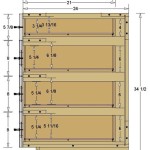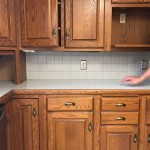DIY Staining Old Kitchen Cabinets: Step-by-Step Guide
Refinishing old kitchen cabinets with stain is a cost-effective way to update the look of your kitchen without replacing them. While it may seem like a daunting task, it's surprisingly straightforward with the right tools and materials.
Before you begin, it's important to choose the right stain for your cabinets. Oil-based stains are more durable and water-resistant, while water-based stains are easier to apply. Once you've chosen your stain, gather the following tools and materials:
- Sandpaper (120-grit, 220-grit)
- Tack cloth
- Degreaser
- Wood filler
- Putty knife
- Stain
- Foam brush or sponge
- Clean rags
- Polyurethane
Now that you have everything you need, let's get started!
Step 1: Remove Doors and Hardware
Begin by removing all of the cabinet doors and hardware. This will make it easier to sand and stain the cabinets.
Step 2: Clean and Degrease
Next, clean the cabinets thoroughly with a degreaser. This will remove any dirt, grease, or debris that could prevent the stain from adhering properly.
Step 3: Sand
Sand the cabinets lightly with 120-grit sandpaper. This will create a smooth surface for the stain to adhere to. Once you're finished sanding, vacuum up the dust and wipe down the cabinets with a tack cloth.
Step 4: Repair Imperfections
If there are any imperfections in the cabinets, such as dents or scratches, fill them in with wood filler. Let the wood filler dry completely, then sand it smooth.
Step 5: Apply Stain
Now it's time to apply the stain. Use a foam brush or sponge to apply an even coat of stain to the cabinets. Follow the grain of the wood and work in small sections.
Step 6: Allow to Dry
Allow the stain to dry completely according to the manufacturer's instructions. This may take several hours or overnight.
Step 7: Apply Polyurethane
Once the stain is dry, apply a coat of polyurethane to protect the finish. You can apply polyurethane with a brush or spray gun. Allow the polyurethane to dry completely and apply additional coats as needed.
Step 8: Reinstall Doors and Hardware
Once the polyurethane is completely dry, reinstall the cabinet doors and hardware. Your newly stained cabinets are now ready to enjoy!

Diy Staining Oak Cabinets Eclectic Spark

Staining Your Wood Cabinets Darker Young House Love

Diy Staining Oak Cabinets Eclectic Spark

How To Stain Oak Cabinetry Tutorial The Kim Six Fix

Gel Stain Kitchen Cabinets Without Sanding Fast Easy Diy

Staining Kitchen Cabinets Pictures Ideas Tips From

Gel Staining Kitchen Cabinets 6 Month Review Merrypad

Refinishing Kitchen Cabinets Modern Refacing Made Easy Wisewood

Budget Kitchen Renovation With Diy Shaker Painted Cabinets I

How To Redo Kitchen Cabinets For A Quick Makeover Yelp
Related Posts








